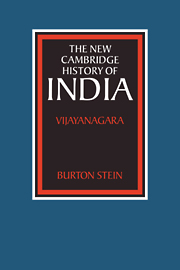Book contents
- Frontmatter
- 1 Introduction
- 2 The medieval past: continuity and disjunction
- 3 The city and the kingdom
- 4 Political economy and society: the sixteenth century
- 5 Imperial collapse and aftermath: 1542–1700
- 6 Conclusion
- Bibliographical essay
- Index
- THE NEW CAMBRIDGE HISTORY OF INDIA
- Frontispiece">
- Plate Section">
- References
3 - The city and the kingdom
Published online by Cambridge University Press: 28 March 2008
- Frontmatter
- 1 Introduction
- 2 The medieval past: continuity and disjunction
- 3 The city and the kingdom
- 4 Political economy and society: the sixteenth century
- 5 Imperial collapse and aftermath: 1542–1700
- 6 Conclusion
- Bibliographical essay
- Index
- THE NEW CAMBRIDGE HISTORY OF INDIA
- Frontispiece">
- Plate Section">
- References
Summary
The city was known by several names besides ‘Vijayanagara’, which is hardly surprising since the earliest inscription from the place in Brahmi script dates from about the second century. From the eleventh to the thirteenth centuries, several other inscriptions are found, including one registering gifts made to the temple of the goddess Hampadevi (or Pampadevi) from which the modern village on the ruins of the city, Hampi, presumably comes. Hoysala-period inscriptions refer to the place as Virupakshapattana or Vijaya Virupakshapura in honour of the god Siva, as Virupaksha, protector of the large settlement the place had become in the fourteenth centruy. These pre-Vijayanagara references make it clear that the future capital of the Vijayanagara kingdom was one of the many places in modern Bellary with a past history dating to Mauryan times when Ashokan edicts were inscribed within thirty miles of Hampi, along banks of the Tungabhadra.
Seventy-seven inscriptions of the Vijayanagara age itself have been discovered around Hampi. Most (sixty-five) are found inscribed on temples along the banks of the Tungabhadra; the balance are in parts of the city that were added during the massive constructions of the sixteenth century by kings of the Tuluva dynasty. Fully half of the inscriptions found on the riverside were on the Vithala shrine. The temples upon whose walls and basements most inscriptions are found display a cosmopolitan character befitting an imperial capital. Stylistic variety and other cultural features of the ruins at Hampi have been carefully analysed during the remarkable efflorescence of Vijayanagara studies that began in the 1970s, to which valuable contributions have come from foreign as well as Indian scholars. Among the former is the architectural historian George Michell, who has documented something of the variety of styles in the built environment of Hampi.
- Type
- Chapter
- Information
- The New Cambridge History of IndiaVijayanagara, pp. 31 - 71Publisher: Cambridge University PressPrint publication year: 1990

